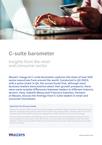
C-Suite barometer: insights from the retail and consumer sector
Optimism for the year ahead
Retail and consumer (R&C) leaders had a fairly negative outlook for 2020, with 45% predicting a drop in revenue compared to the previous year, 10 points above the average (35%). However, when it comes to the year ahead, 70% said they were expecting growth in 2021, just one point below the average.
The downbeat expectations for 2020 are easy to understand, given the immediate and direct impact of the pandemic on many parts of the R&C sector as a whole. Apart from designated ‘essential shops’, retailers in many countries were forced to close for several months, with many reporting a drop in sales of more than 50%.
Online shopping explosion
At the same time, the switch to online shopping gave R&C businesses a much needed route forward, with many retailers reporting an increase of 40%-50% in online sales. Kantar research into UK, French and German retail trends found the share of people undertaking 50% or more of their total purchases online grew by between 25-80% in April 2020 alone, and six in ten consumers intended to continue buying as much online once the pandemic had passed.
This trend was already occurring, but the crisis hugely accelerated it. E-commerce is no longer mainly for younger people, everybody is buying more and more online, and retailers will need to adapt and continue to evolve to keep up with the expectations of consumers. This has created a new baseline for e-commerce sales that is only going to increase further in future. This will mean more investment from retailers to capitalise on these opportunities.
As the year progressed, retailers adapted fast to ramp up their e-commerce capabilities and fine-tune their online operation to capitalise on the increasing opportunities. Now the systems, infrastructure and processes are in place, and with online sales expected to continue growing, retailers are understandably more positive for their 2021 expectations.
Proactive and resilient
The resilience of R&C businesses in adapting to the situation is also demonstrated in the 50% of R&C leaders who prioritised ‘developing new services, markets and business models’ as the most likely transformation they would undertake in the next three-to-five years. This contrasts with the overall survey consensus, which placed this strategy at number three in terms of likely transformations, behind technology transformations and performance improvement.
Most R&C businesses have had to change their business models to some extent over the past 12 months, just to survive the pandemic. That’s not to say they implemented brand new business models, but existing models, practices and strategies had to be re-engineered in response to the crisis. Faced with the new consumer reality, this will need to continue over the next few years, not in terms of ‘what’ they do, but in terms of ‘how’ they do it. This will involve everything from investing in the digital experience, to re-thinking inventories and shortening supply chains.
“There is a new baseline for online sales that is only going to increase in future. This will mean more investment to capitalise on these opportunities.” |
Francisco Sanchez, Partner, Mazars |
Personalised services
The huge growth of online shopping will lead to an even bigger expansion in data and the opportunities it creates. Leveraging this data to provide more tailored, individual experiences, with higher levels of service both before and after the sale, is a huge opportunity for R&C businesses to refine their services to meet evolving consumer preferences and develop deeper relationships with their customers.
Luxury brands have already started moving in this direction. Mazars’ recent report on the evolution of the luxury sector discusses some of the ideas, insights and strategies that could benefit other parts of the R&C sector.
Sustainable considerations
Sustainability is also expected to become a bigger factor in consumer preferences, another trend which was already growing, but which has been accelerated by the pandemic. In the short term, people were encouraged to shop local because of Covid, but it is a trend that has grown over the last decade, as people choose to shop near where they live rather than venture to out-of-town retail parks and hypermarkets.
Responding to this will likely mean a certain amount of transformation on the part of retailers, in terms of the way they implement and communicate their approach to sustainability, as well as operational considerations such as supply chains, logistics and product portfolios.
Acting short term, thinking long term
More R&C businesses expected to shift towards a short-term orientation in 2021.
At the time of completing the survey, 68% said they had been long-term orientated in the six months previously, but only 53% planned to be in the following six months, suggesting a change in priorities towards short-term activities.
Retail is essentially a short-term business with low margins. The impact of the pandemic was direct and immediate. Businesses had to act quickly or else they would not have survived. Many retailers were already facing a difficult commercial environment before the crisis. If they want to win more customers, it often comes down to lower prices. Discounts can help retailers attract and retain customer interest, especially with an economic recession likely. But it is difficult to invest in lower prices if you are working with very low margins. It is not surprising that retailers are looking to adapt faster than other sectors by taking short-term actions such as reducing headcount and managing suppliers.
This speed of response will continue to be critical going forward, as the retail sector evolves at breakneck speed. It doesn’t mean long-term strategies are being neglected, but to have time to plan for, and invest in the long term, they first need to survive in the short term.
“Luxury brands have led the way with many of the changes facing the R&C sector, such as customisation, personalisation, after service support and sustainability.” |
Isabelle Massa, Partner, Mazars |
Low levels of female leaders
One of the most surprising results of the C-suite barometer for the R&C sector was the lack of female top strategic decision-makers [1]; nine out of ten businesses in this sector have less than 50% female decision-makers.
It is important to note that the proportion is likely to vary between different R&C areas and sub-sectors. Women are well represented in management roles in luxury and fashion brands, for example, and in outlet management. In some countries, such as France, it could also reflect the fact that female leaders are potentially more likely to gravitate towards industry sectors that have stronger protections for women’s working rights, such as banking and finance.
Nevertheless, it is a puzzle that the R&C sector needs to solve in the coming years as it seeks to attract and retain the best talent with the diverse skills needed to navigate a successful path towards future growth.
[1]. In this survey “top strategic decision maker” was defined as “typically, members of your company's Executive Committee or Management Board, or employees who make strategic decisions at a similar level.”
Adapting to a new future
The pandemic was a huge shock to the retail sector, but it should not mean that retailers’ existing strategies need to be totally rebuilt. Most of the challenges it presented – and which are reflected in the findings of the C-suite Barometer – were an amplification of existing developments, rather than entirely new ones. Online sales were already growing exponentially in most markets. This, combined with innovations in technology and data processing, changed the way customers expected to be serviced, with a greater focus on personalisation and authenticity. It was also feeding into increasing awareness – and concern – around sustainability. And, of course, greater online competition was inevitably putting a downwards pressure on prices.
These key issues – e-commerce, personalisation, sustainability and pricing – should already be at the heart of retailer strategies, Covid crisis or not. As indicated by the 70% of respondents who said they were expecting growth in 2021, retailers who address these issues successfully can look forward to stronger loyalty and increasing sales over the next few years.
Read the full C-suite barometer report here.


